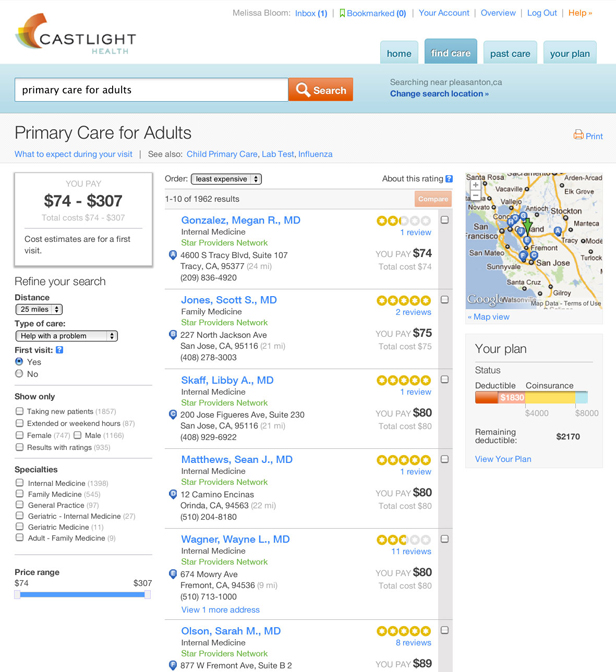Exposing the Cost of Health Care

Travelocity for medicine: Castlight’s data-driven tool sheds light on the costs of medical care, information that can be difficult for consumers to find on their own.
Credit: Castlight Health
It’s easy to compare prices on cameras, vacations, and homes. But in the United States, patients fly blind when paying for health care. People typically don’t find out how much any given medical procedure costs until well after they receive treatment, be it a blood draw or major surgery.
This lack of transparency has contributed to huge disparities in the cost of procedures. According to Castlight Health, a startup based in San Francisco, a colonoscopy costs anywhere from $563 to $3,967 within a single zip code. EKGs can range from $27 to $143, while the price for a set of three spinal x-rays varies from as little as $38 to as high as $162.
When someone else is picking up the tab, mystery pricing is not much of a problem. But these days, even the 59.5 million Americans who get health benefits through large self-insured employers are increasingly expected to pay a percentage of the costs for their medical care.
Castlight aims to do as its name suggests: cast light on the actual costs of medical care, so that people can make informed decisions. The company, founded in 2008 by entrepreneurs Giovanni Colella and Todd Park, now chief innovation officer for the U.S. Department of Health and Human Services, offers computer-based tools that let people comparison shop for health care in much the same way they would for airline tickets on Travelocity or for cars on Cars.com.
The company sells its tool to self-insured employers, who pay a fee per covered member per month, and in turn offer employees access so they can become more responsible users of their benefits. It has raised $81 million in venture funding to date. Current customers include Safeway and Life Technologies, a leading maker of genomics tools.
“Castlight is further along than anybody else in helping big employers show their employees that the individual decisions they make on health care actually do have a cost that affects benefits and wages,” says Matthew Holt, co-chairman of Health 2.0, a health-care consultancy firm.
Castlight gathers data on medical costs primarily from statements of benefits that insurers provide to large employers after workers’ claims have been paid. The firm also provides information about quality, which it gathers from a variety of sources, including the federal Health Data Initiative, a nonprofit coalition of employers called the Leapfrog Group. Along with quantitative data, the company aggregates patient reviews from consumer websites. “We arguably have the richest and most comprehensive quality measures of any website today,” says Ethan Prater, vice president of product marketing at Castlight.
The company’s growth depends in part on cooperation from insurers. While some, including Cigna and Aetna, have been willing to share data about the prices they pay health-care providers like doctors and hospitals, other insurers insist that such information is a trade secret.
“Without that information, Castlight can’t fulfill its mission to help consumers make decisions based on cost and quality,” says Jane Sarasohn-Kahn, a health economist and management consultant. But the balking is hardly surprising, she says, because transparency on costs doesn’t benefit insurers or providers, it benefits the purchaser—and, potentially, new businesses like Castlight Health that aim to empower consumers.
Keep Reading
Most Popular
Large language models can do jaw-dropping things. But nobody knows exactly why.
And that's a problem. Figuring it out is one of the biggest scientific puzzles of our time and a crucial step towards controlling more powerful future models.
The problem with plug-in hybrids? Their drivers.
Plug-in hybrids are often sold as a transition to EVs, but new data from Europe shows we’re still underestimating the emissions they produce.
Google DeepMind’s new generative model makes Super Mario–like games from scratch
Genie learns how to control games by watching hours and hours of video. It could help train next-gen robots too.
How scientists traced a mysterious covid case back to six toilets
When wastewater surveillance turns into a hunt for a single infected individual, the ethics get tricky.
Stay connected
Get the latest updates from
MIT Technology Review
Discover special offers, top stories, upcoming events, and more.